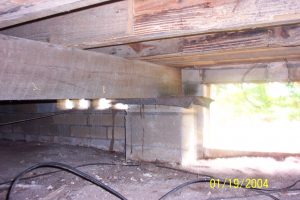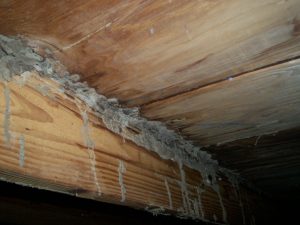 Termite shields have been around for decades and are suppose to block termite entry while reducing the need for chemicals. Most often constructed of rust free metal they are designed for crawl space foundations or piers. On occasion I have found them on monolithic and supported slab construction but that is rare.
Termite shields have been around for decades and are suppose to block termite entry while reducing the need for chemicals. Most often constructed of rust free metal they are designed for crawl space foundations or piers. On occasion I have found them on monolithic and supported slab construction but that is rare.
This simple method however is not a recognized treatment by any governmental agencies I’m aware of and I see so few of them on newer home construction. The added cost to a home is very minimal and the possible desired effects could last for years on end if done correctly.
The idea is to place a continuous metal barrier at the top of the foundation walls with no seams or breaks and should stick out about 2 to 3 inches and bent downward at a 45 degree angle. Termites passing up through the hollow block or a crack would be forced out and become visible and once exposed they could be treated. Termites also have a hard time making 90 degree turns and the lip of the shield would provide this obstacle.
I’ve seen many instances where the shield has worked very well, you could see the searcher tunnel reach the barrier and branch out in an effort to get by but then the tunnel stops and it seems they abandoned the attack. More than not however I have seen this method fail. In those instances it’s almost always due to poor construction of the shield or corrosion and damage have provided the break they needed. On rare occasions the persistent termite colony manages to get by an intact barrier and the tunnel reaches its prize.
you could see the searcher tunnel reach the barrier and branch out in an effort to get by but then the tunnel stops and it seems they abandoned the attack. More than not however I have seen this method fail. In those instances it’s almost always due to poor construction of the shield or corrosion and damage have provided the break they needed. On rare occasions the persistent termite colony manages to get by an intact barrier and the tunnel reaches its prize.
While termite shields are not recognized as a treatment per se (I’m not sure why) they can be a valuable tool in safeguarding any home from the ravages of this wood destroying insect. Just like tubes in the wall systems however they can only be installed during construction and they are only as good as the people putting them in. One errant nail hole or misaligned seam even as small as 1/64th of an inch is all that the termite needs to gain access.
If I were constructing a home with a pier foundation a termite shield would definitely be on my list of things to install. I would also consider hiring a pest control professional to oversee that part of the building process just for their keen eye to help get it right.
 Although it’s not the end all do all of termite barriers it is an effective way to deter termite attacks and I can’t think of any treatment that would be considered more environmentally responsible. In this age of saving the planet and ‘green’ pest control I’m surprised that the termite shield hasn’t gotten more love, especially if you consider the alternative.
Although it’s not the end all do all of termite barriers it is an effective way to deter termite attacks and I can’t think of any treatment that would be considered more environmentally responsible. In this age of saving the planet and ‘green’ pest control I’m surprised that the termite shield hasn’t gotten more love, especially if you consider the alternative.




